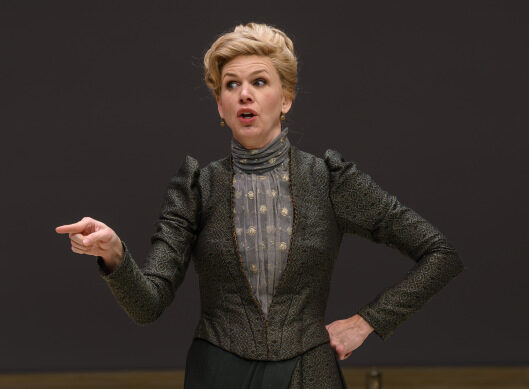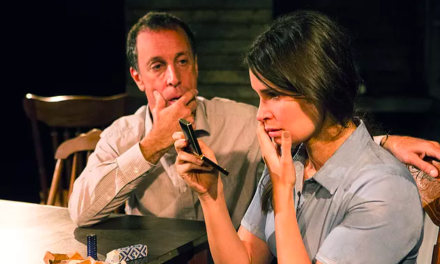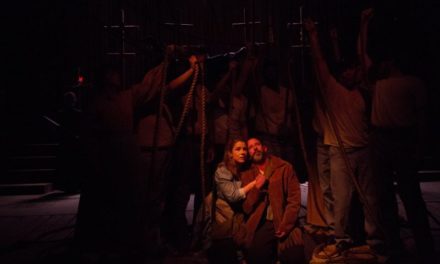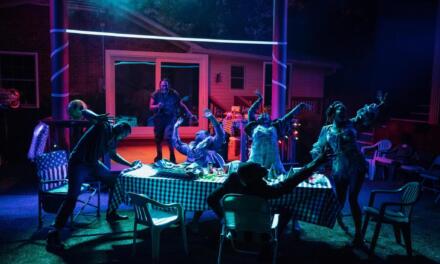A large–one might venture to say, deliberately oversized–dark blue door dominates the elegantly curved wall of the Helmer home in the Pittsburgh Public Theater’s production of Lucas Hnath’s deservedly much-acclaimed A Doll’s House Part 2.
Of course, it does. That’s a famous theater-history door, a famous 19th-century “Woman Question” door: it’s the door that slammed behind Nora after she walked out on a marriage that had infantilized her and robbed her of autonomy and self-actualization.
Now she’s returned, back through that same door, fifteen years later, and she is a changed woman. She’s a successful writer of popular novels that help other women see how the patriarchal institution of marriage oppresses them, and she confidently dreams of a time, “in twenty or thirty years,” when marriage will “just end.”
Unfortunately for Nora, she has recently discovered that despite what she has been publicly advocating, her own marriage has, in fact, never officially “ended”: her husband, Torvald, never filed for divorce after she left. This puts her in an awkward and potentially criminally liable situation, as she has done all sorts of things married women in the 19thcentury are not legally permitted to do (like: take lovers and sign contracts). Patriarchy being what it is (and living in it as we do, we all know what it is), the obstacles for her to file for divorce are greater than they would be for Torvald, so she’s come back to ask him to do what he was supposed to have done fifteen years ago, and officially end their marriage.
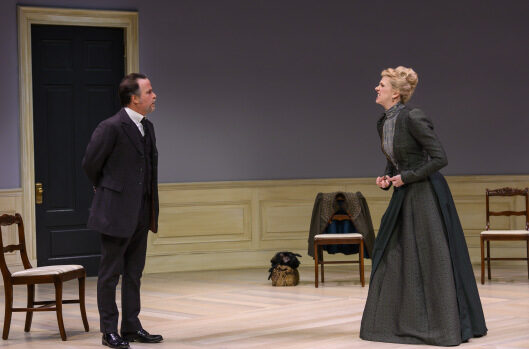
L to R: Daniel Krell and Lisa Velten Smith. Photo by Michael Henninger, courtesy Pittsburgh Public Theater.
The reason this play’s acclaim is well-deserved is that it achieves precisely what really good playwriting ought to achieve–it gives each of its characters clearly differentiated goals and needs and then allows each of its characters to fully persuade you of the rightness of their position. Thus what seems easy and straightforward to Nora is much more complicated when seen from Torvald’s side of things. Torvald doesn’t want to give Nora what she’s come for, partly out of wounded pride, and partly because he thinks that she did the “easy” thing by walking away from the marriage instead of doing the hard work of relationship repair–and he’s got a really good point, one that might even have you on his side for a minute or two. He also has other reasons–which I won’t spill because it would spoil the plot–that align pitch-perfectly with the passive-aggressive personality that Ibsen gave his Torvald and remind you that Nora was actually right to walk out on the schmuck.
Those reasons are divulged by Emmy, Nora’s now-grown daughter, whose own position on marriage comes as dismay to her mother. Where Nora sees no benefit to the institution, Emmy craves companionship, love, and stability, and shrinks with disgust from Nora’s utopian vision of a future world in which people couple up without long-term commitment–and here, too, you might find yourself swayed to Emmy’s side of the argument. But then Nora later makes a very compelling case for autonomy–for the necessity for women to escape (or avoid) the institutions that mold them to social expectations and keep them from finding their own voices–and you wonder if Emmy has merely drunk the patriarchal kool-aid. Back and forth this play goes, endowing each of its four characters with a compelling point of view that perpetually shifts your perspective on their shared dilemma (there’s also Anne Marie, the elderly housekeeper, whose generation, class, and status give her yet another view of the family’s central conflict).
The play is set in the 19thcentury, but its dynamics and its politics feel fresh and contemporary. This is partly due to the anachronistic dialogue, which is at times startlingly frank (and garners a lot of laughs, particularly when the seemingly prim Victorian characters drop the f-bomb). But it’s mainly due to the ways Nora’s frustrations with a rigged system still echo with modern experience. She’s not only up against a double standard at nearly every turn, but she’s also fighting an all-too-familiar battle to assert her voice in a world that diminishes and dismisses women’s ideas. Hnath slyly and cogently captures this dynamic in a confrontation between Nora and Torvald, in which Nora sums up all of the ways in which her marriage to Torvald was one long episode of mansplaining–and then Torvald, denying the charge, subsequently proceeds to interrupt and talk over her.
The production at PPT, directed by Ted Pappas, is beautifully realized in every dimension. James Noone’s elegant, spare set simultaneously evokes 19th-century Scandinavia, with its blonde wood floor and austere décor, and a Roman forum, with its rotunda shape and high ceilings. That latter choice feels right for a play that pits such clearly differentiated positions against each other. The ensemble brings the play’s conflicts to life with precise characterization and exquisite comic timing. Helena Ruoti limns Anne Marie as a crabbed, limping spinster–hands balled in arthritic spasms, in a nice physical detail–who possesses the blunt frankness that comes of aging past diplomacy. Marielle Young is equally straightforward as Emmy, the daughter who never really knew her mother but who has nonetheless not fallen far from the tree: Young’s Emmy demonstrates a savviness and assertiveness that connects her to Nora, despite the difference in their aspirations. Daniel Krell gives depth and humanity to his portrayal of Torvald, rounding him out so much that you can’t help but feel a bit sorry for the bastard, particularly when he comes to see himself through Nora’s eyes. And anchoring the whole show, the phenomenal and commanding Lisa Velten Smith brings a rich, sardonic complexity to Nora as she swooshes regally about the stage in a gorgeous, heavy dress (designed by Gabriel Barry) and navigates her way through the shifting argumentative landscape with fierce intelligence and razor-sharp focus.
This article was originally posted in The Pittsburgh Tatler on March 17, 2019, and has been reposted with permission.
This post was written by the author in their personal capacity.The opinions expressed in this article are the author’s own and do not reflect the view of The Theatre Times, their staff or collaborators.
This post was written by Wendy Arons.
The views expressed here belong to the author and do not necessarily reflect our views and opinions.

